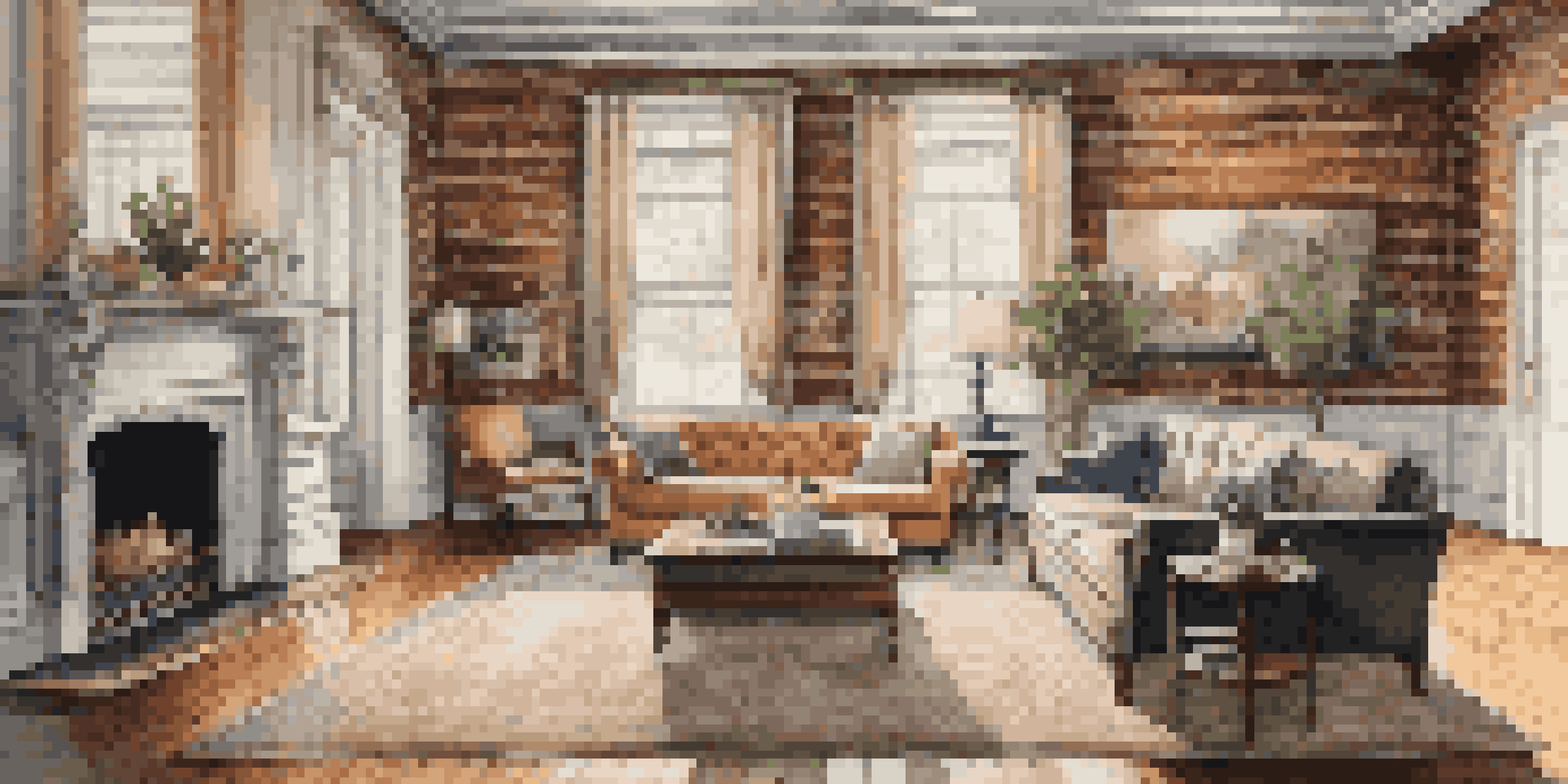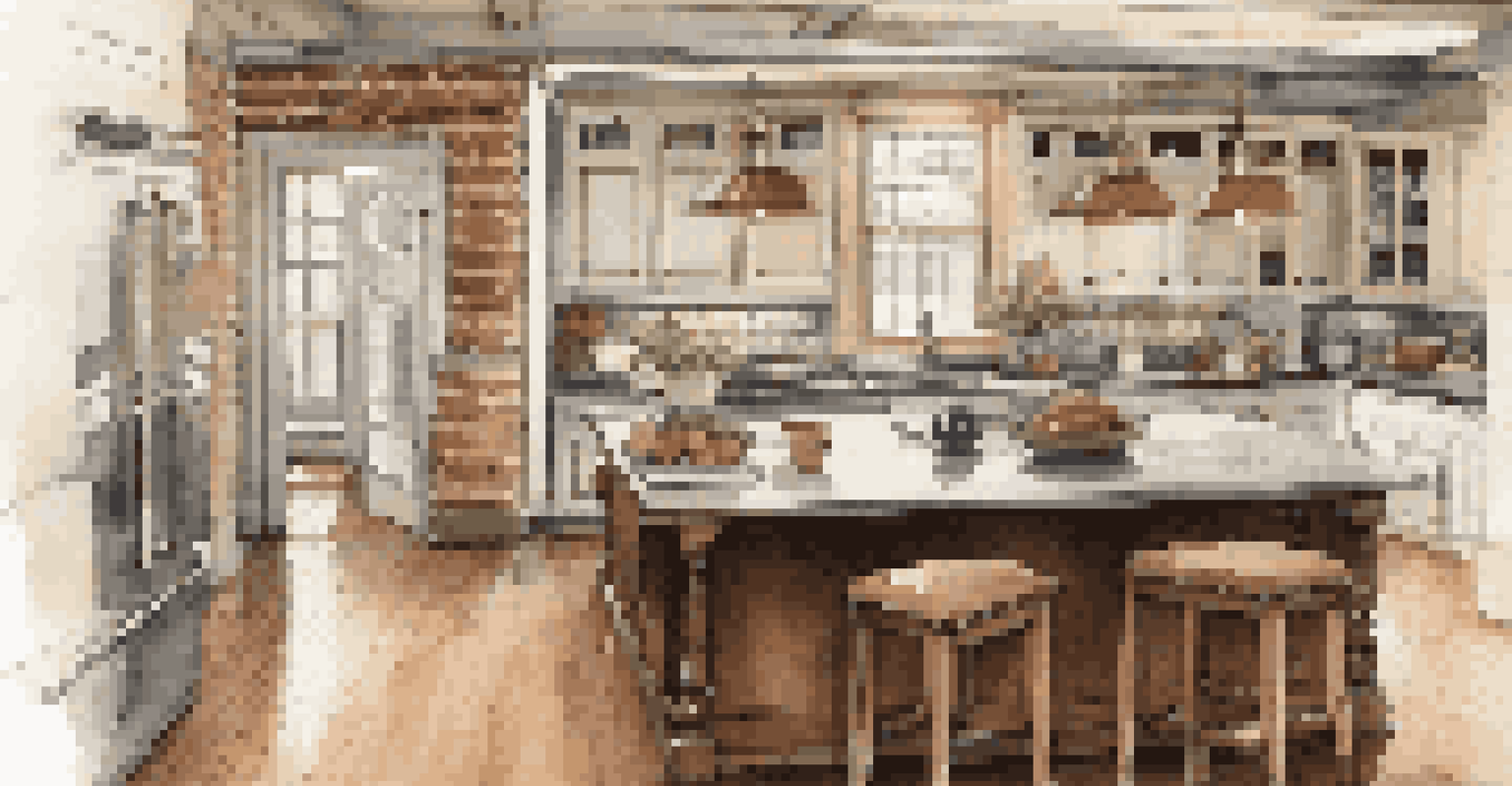Adapting Historic Spaces for Modern Living: A Practical Guide

Understanding the Unique Charm of Historic Spaces
Historic spaces carry stories and character that can't be replicated. They often feature unique architectural elements, like ornate moldings or vintage windows, that give them a distinct personality. Recognizing what makes these spaces special is crucial when considering renovations or adaptations.
Old buildings are like old friends; they have stories to tell and character to share.
These buildings often reflect the era they were built in, providing a glimpse into history that modern constructions lack. However, this charm can sometimes clash with contemporary needs, creating a challenge for homeowners. Embracing the quirks of a historic space while planning for modern functionality is key to striking the right balance.
For instance, an old warehouse might boast high ceilings and exposed brick, perfect for a trendy loft. By understanding the original character of a space, you can create a living environment that honors the past while catering to today's lifestyle.
Assessing the Structure and Layout
Before diving into any renovations, it's essential to assess the existing structure and layout. This includes checking the foundation, roof, and walls for any signs of wear or damage. A thorough inspection can save you from costly surprises later on and help you identify areas that may need reinforcement.

Consider how the current layout serves your needs. Perhaps the original design has rooms that are too small or poorly configured for modern living. This is the perfect opportunity to think creatively about how to reconfigure spaces without losing their historical essence.
Embrace Historic Charm in Renovations
Adapting historic spaces requires balancing their unique character with modern functionality.
For example, if a historic home has a closed-off dining room, consider opening it up to the kitchen for an open-concept feel, while maintaining original details like moldings. This blend of old and new can create a functional space that feels both inviting and timeless.
Preserving Key Historical Features
One of the most rewarding aspects of adapting historic spaces is the opportunity to preserve beautiful architectural details. Features like crown molding, hardwood floors, and original fireplaces should be treated with care. These elements not only enhance aesthetic appeal but also contribute to the home’s historical value.
Preservation is not about the past, it's about the future; it's about the stories we choose to tell.
When planning renovations, consider how to highlight these features rather than hide them. For instance, instead of covering a stunning brick wall, think about how you can incorporate it into your design, perhaps by using it as a focal point in a living area.
Additionally, preserving these details can often increase the market value of your home. Buyers are typically attracted to homes that blend history with modern amenities, making your investment worthwhile in the long run.
Incorporating Modern Amenities Thoughtfully
Adapting historic spaces for modern living doesn’t mean you have to sacrifice comfort or convenience. Thoughtful integration of modern amenities can enhance the function of your space while respecting its character. For example, installing energy-efficient windows can improve insulation without compromising the historical look.
Consider the use of smart home technologies that can be discreetly integrated, like smart thermostats or automated lighting. These features can enhance your living experience, making your home more comfortable and efficient.
Preserve Key Architectural Features
Highlighting original details like moldings and fireplaces enhances both aesthetic appeal and historical value.
However, it's crucial to ensure that any new installations harmonize with the existing architecture. For instance, choosing fixtures and appliances that reflect the era can help maintain the overall aesthetic while providing modern functionality.
Navigating Local Regulations and Preservation Guidelines
When adapting a historic space, it's important to understand local regulations and preservation guidelines. Many historic buildings are protected by laws that aim to maintain their character and integrity. Familiarizing yourself with these rules will help you avoid potential legal issues during your renovation project.
You may need to seek permission for certain alterations, especially if they affect the exterior appearance or structural integrity. Engaging with local preservation societies can provide valuable resources and guidance. They may even offer insights or support that can enhance your project.
Being aware of these regulations not only helps you stay compliant but also encourages you to think creatively within the established framework. This can lead to innovative solutions that honor the building’s history while meeting modern needs.
Finding the Right Professionals for Your Project
Choosing the right professionals for your renovation is crucial when adapting historic spaces. Look for contractors and designers who have experience with historic properties and understand the nuances involved. Their expertise can make a significant difference in achieving a successful blend of old and new.
Ask for recommendations or check portfolios to gauge their understanding of preservation techniques and modern design principles. A knowledgeable team will help you navigate the challenges that come with working on older buildings and ensure that your vision is realized.
Choose Professionals Wisely
Selecting experienced contractors for historic properties ensures a thoughtful blend of old and new in your renovation.
Collaborating with professionals who share your appreciation for historic spaces can lead to innovative solutions that respect the integrity of the building. This partnership can ultimately result in a home that feels cohesive and thoughtfully designed.
Creating a Cohesive Design Aesthetic
Once you've made the necessary assessments and gathered your team, it's time to focus on creating a cohesive design aesthetic. This involves blending modern elements with historic features in a way that feels harmonious. Consider a color palette and material choices that complement the building's original character.
Using a mix of vintage and contemporary furnishings can also enhance the overall look. For instance, pairing a sleek modern sofa with a vintage coffee table can create a dynamic and inviting living space. The key is to find balance; neither style should overpower the other.

Additionally, thoughtful decor can tie together different elements of your design. Incorporating artwork or accessories that reflect both the historic and modern aspects of your home can create a seamless transition between eras.
Enjoying the Best of Both Worlds in Your Home
Once your renovations are complete, it's time to enjoy the best of both worlds in your newly adapted historic space. Living in a home that honors its past while providing modern comforts can be incredibly rewarding. You’ll find that your space tells a story, blending history with personal touches.
Hosting friends and family in a space that reflects both your style and the building's character can create lasting memories. The unique features of your home, combined with modern conveniences, provide a warm and inviting atmosphere.
Ultimately, adapting historic spaces for modern living is about celebrating the journey of your home. Embrace the stories it holds while making it a comfortable and stylish place to live, showcasing the beauty of both its history and your personal touch.